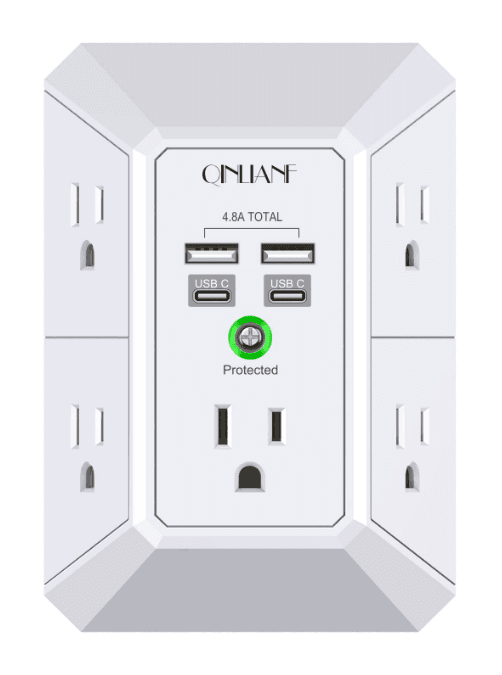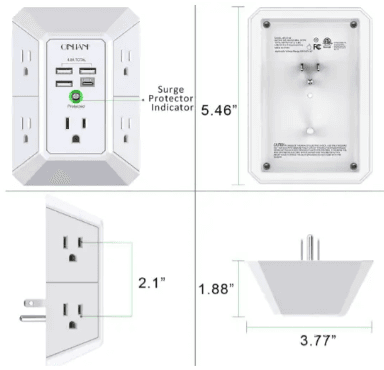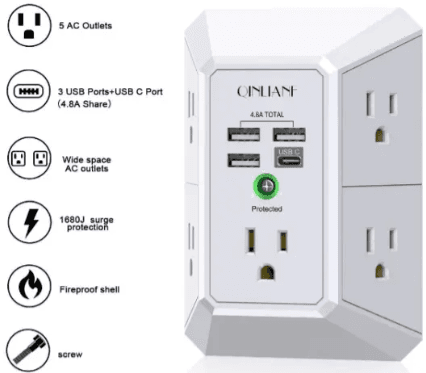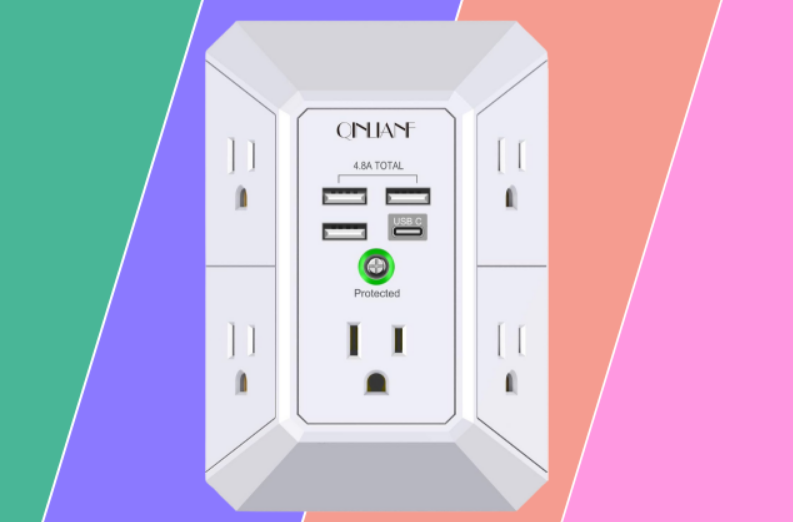
QINLIANF USB Wall Charger Surge Protector Outlet Extender

Introduction
The introduction section typically provides an overview of the product, its purpose, and its key selling points. This is where you’ll learn about why the QINLIANF HR-519D Surge Protector Power Strip is designed and what it offers.
Specifications
What’s in the box
This section typically outlines what comes in the package when you purchase the product. It may include the power strip itself, the user manual, and any additional accessories or components.
Features
Here, you’ll find a detailed list of the features and functions of the product, which might include:
- Surge protection
- Multiple power outlets
- USB charging ports
- Indicator lights
- Safety shutters
- Overload protection
- EMI/RFI filtering
- Mounting options
- Energy-saving features
Dimension

How to Use
Inspect the Surge Protector
Before use, inspect the power strip for any visible damage, such as cracks, exposed wires, or damaged outlets. Do not use a damaged surge protector.
Location
Choose a suitable location to place the surge protector. It should be easily accessible and close to the devices you want to protect.
Plug into an Outlet
Insert the plug of the surge protector into a wall outlet or a grounded outlet. Ensure that it fits securely, and the surge protector’s indicator light (if present) is on.
Connect Your Devices
Plug your electronic devices or appliances into the outlets on the surge protector. Be mindful not to overload the surge protector by connecting too many high-wattage devices. Most surge protectors have a rating indicating their maximum load capacity.
Reset and Test Buttons
Some surge protectors may have reset and test buttons. The reset button allows you to restore protection after a surge event, while the test button can be used to verify that the surge protection feature is functioning correctly. Refer to the user manual for specific instructions on using these buttons.
Cable Management
Arrange the cables neatly to avoid tangling and reduce the risk of tripping hazards. Some surge protectors have built-in cable management features.
Grounding Indicator
Check if the surge protector has a grounding indicator, which typically shows that the surge protector is properly grounded. A grounded surge protector provides better protection.
Surge Protection Status
Many surge protectors come with indicator lights to show whether the surge protection is still functional. Check these lights regularly to ensure your devices are protected.
Replace as Needed
Surge protectors have a finite lifespan and can wear out over time, especially if they’ve absorbed a significant surge. Some surge protectors come with a status indicator that will notify you when it’s time to replace them. If in doubt, it’s a good practice to replace your surge protector periodically.
5 AC OUTLES+3 USB PORTS †USB C PORT

Safety
- Check the Rating: Ensure that the surge protector’s electrical rating matches the voltage and current requirements of the devices you intend to plug into it. Overloading a surge protector can pose fire hazards.
- Grounding: Verify that the surge protector is properly grounded. It should have a three-prong plug and be plugged into a three-prong outlet. Never use adapters to bypass the grounding pin.
- Cord Inspection: Regularly inspect the power cord for any signs of damage, such as cuts, fraying, or exposed wires. Do not use the power strip if you find any issues.
- Indicator Lights: Familiarize yourself with any indicator lights on the surge protector. Some models have lights to show if the unit is functioning correctly. If the indicator light is off, it may indicate a problem with the surge protector.
- Reset Button: Many surge protectors have a reset button. If the surge protector has tripped or shut down due to a surge, press the reset button to restore power. If it continues to trip, investigate the cause of the surges and address them.
- Surge Protection Status: Understand the surge protector’s lifespan. Surge protectors wear out over time, so be aware of when they might need replacement. Some models have indicator lights that signal when the surge protection is no longer active.
- Proper Use: Use the surge protector for its intended purpose and do not daisy-chain multiple power strips or extension cords together, as this can overload circuits and create fire hazards.
Maintenance
Cleaning
Dust and debris can accumulate on and around the power strip, potentially causing overheating. Unplug the devices, then turn off and unplug the power strip before cleaning it. Use a dry cloth or compressed air to remove dust and dirt from the outlets and the housing.
Avoid Overloading
Do not overload the surge protector by plugging too many devices into it. Ensure you stay within the specified load capacity mentioned in the user manual. Overloading can reduce the effectiveness of surge protection.
Cable Management
Keep the power strip and its cables organized to prevent tripping hazards and to avoid wear and tear on the cables.
Battery Backup (If Applicable)
If the surge protector includes a battery backup for an uninterrupted power supply (UPS), periodically check the battery status and replace it according to the manufacturer’s recommendations.
Test Functionality
Some surge protectors have indicator lights or buttons to test the functionality of the surge protection. Periodically test the surge protection feature according to the manufacturer’s instructions to ensure it’s still working correctly.
Replace if Damaged
If the power strip experiences a power surge or becomes damaged in any way, it may not provide adequate protection. Consider replacing it, especially if it’s taken a direct lightning strike or experienced a significant power surge.
Outlet Covers
Consider using outlet covers to protect unused outlets from dust and debris, and to prevent children or pets from inserting objects into the unused outlets.
Grounded Outlets
Ensure that the power strip is plugged into a properly grounded outlet to maximize surge protection.
Troubleshooting
No Power or Indicator Light
Ensure the power strip is plugged into a working electrical outlet. Check the surge protector’s power switch to make sure it’s in the “On” position.
Verify that the power strip’s internal circuit breaker (if it has one) is not tripped; you may need to reset it.
Surge Protection Failure
If your devices are not adequately protected during a power surge, it may indicate that the surge protector has worn out. Surge protectors have a limited lifespan and can become less effective over time. Consider replacing it.
Device Not Charging or Power Loss
Check if the surge protector is connected to a power source and that the devices you’re trying to charge are properly connected to the power strip and turned on.
Ensure that the total power drawn from connected devices does not exceed the power strip’s capacity. Some power strips have a built-in overload protection feature that may cut power if exceeded.
Tripped Circuit Breaker
Some surge protectors have a built-in circuit breaker that can trip in response to an overload. If the circuit breaker has tripped, unplug some devices to reduce the load and then reset the circuit breaker according to the manufacturer’s instructions.
Damaged Cord or Plug
Examine the power cord and plug for any visible damage or wear. If you notice any, it’s essential to replace the power strip.
Reset Button
Some surge protectors have a reset button to restore power after a surge event or a trip. Check the surge protector for such a button and follow the manufacturer’s instructions to reset it.
Disconnected Ground:
Ensure that the surge protector is properly grounded. The ground prong on the plug should be securely inserted into the grounded outlet.
Overloading the Surge Protector
Be mindful of the number of devices connected and their power requirements. Overloading the surge protector can lead to overheating and malfunction.
Compatibility Issues
Some surge protectors may not be compatible with certain devices or power adapters. Ensure that the devices you’re connecting are suitable for use with the power strip.
Replace If Outdated
Surge protectors have a limited lifespan and can become less effective over time. If your surge protector is old or has been through significant power surges, it may be time to replace it.
FAQs
What is the QINLIANF HR-519D Surge Protector Power Strip?
The QINLIANF HR-519D is a surge protector power strip designed to protect your electronic devices from power surges and provide multiple power outlets.
How many power outlets does this power strip have?
The HR-519D power strip typically features a specific number of power outlets, with options for accommodating various devices.
Does this power strip come with USB charging ports?
Some models of the HR-519D power strip include built-in USB charging ports for charging mobile devices.
Is this surge protector suitable for high-power appliances?
The power strip is typically designed for low to medium power devices and may not be suitable for high-power appliances like refrigerators or air conditioners.
Does the power strip provide surge protection for connected devices?
Yes, it usually includes surge protection to safeguard connected devices from voltage spikes and power surges.
Is the power strip suitable for international use (110-240V)?
Some versions of the HR-519D power strip are compatible with a wide voltage range (110-240V) and may include interchangeable plugs for international use.
Is there an on/off switch or master control for the power strip?
Many power strips include an on/off switch or master control to easily manage power to connected devices.
What is the power cord length of the HR-519D power strip?
The length of the power cord can vary, but it is often around 6 feet (1.8 meters) for convenience in placement.
Is there a warranty provided with the power strip?
Warranty coverage may vary by the seller, but some packages include a limited warranty to ensure product quality and reliability.
Can the power strip be mounted on a wall or under a desk?
Some power strips have mounting options, such as keyholes for wall mounting or brackets for under-desk installation.
For more Manuals by QINLIANF, visit ManualsLibraryy
QINLIANF USB Wall Charger Surge Protector Outlet Extender-FAQs
What does a surge protector outlet do?
A surge protector shields your devices from power surges, voltage spikes, and electrical noise that can damage or disrupt electronics plugged into standard outlets.
Is it safe to charge my phone through a surge protector?
Yes, it’s completely safe. Surge protectors offer extra safety by protecting your phone charger from sudden power spikes while acting like a standard outlet extender.
What is another name for a surge-protected outlet?
Surge-protected outlets are also known as Surge Protection Devices (SPD) or Transient Voltage Surge Suppressors (TVSS), especially in larger electrical and industrial setups.
How do outlet protectors work?
Tamper-resistant outlets have a built-in shutter mechanism that only opens when equal pressure is applied to both sides—keeping kids safe and preventing accidental contact.
Should a surge protector get hot?
No, it shouldn’t. If your surge protector feels hot to the touch, it might be overloaded. Unplug it immediately and stop using it to avoid any safety risks.
How many devices can I plug into one surge protector?
Surge protectors can power multiple devices—often 6 or more—depending on the model. Just be sure not to exceed the total power load recommended.
Where should I use a surge protector?
Use surge protectors with valuable electronics like TVs, computers, gaming consoles, and phone chargers—any device that could be costly to replace after a power surge.
What voltage do standard outlets in the U.S. provide?
Most household outlets in the U.S. deliver 120 volts on circuits rated at 15 or 20 amps.


